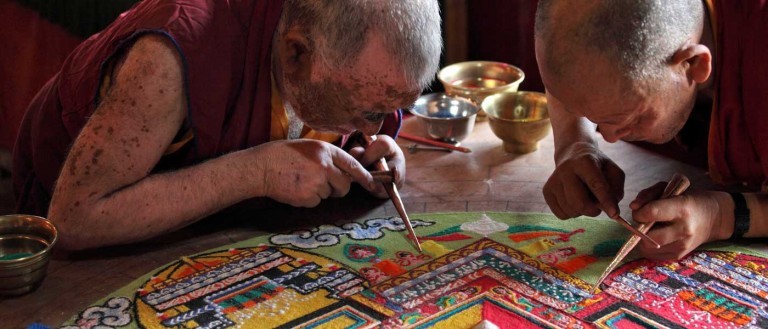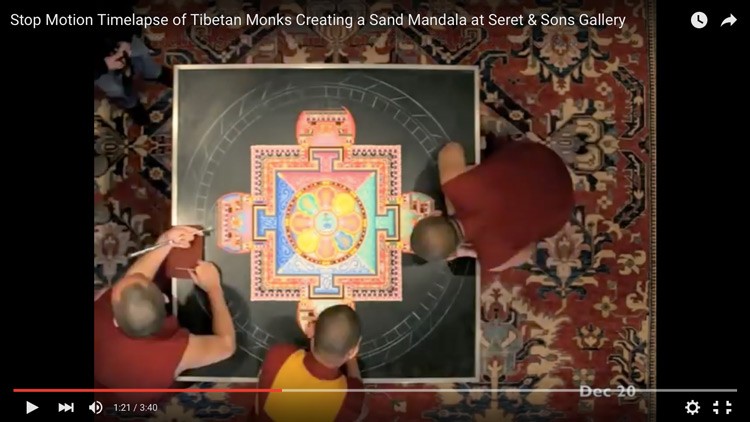Tibetan Mandala - An Exquisite Artform, Rarely Seen by Outsiders
Tibetan Mandala refers to one of the most exquisite, fascinating forms of art you're ever likely to discover. But as you'll see, very few people will ever have the privilege of seeing one in real life. We were fortunate enough to do so, and it's a memory that will never leave us.
If you know of Tibetan Mandala Art, then understanding more is important to appreciate it fully. But if you've not come across it before, you're in for a treat.
What is Tibetan Mandala Art?
First thing first - what is Tibetan Mandala? It's a form of art originating centuries ago in Tibet. Mandalas are painstaking created by Buddhist monks, and consist of intricate patterns created by hand with coloured sand, filled with deep spiritual, religious and cultural meaning.
For many centuries, this amazing art form was kept a closely guarded secret amongst its Tibetan Buddhist practitioners. But the current Dalai Laima chose to treat it as a cultural rather than purely religious creation, and allowed the outside world to learn about it.
While learning about the artform and what's behind it, newcomers also gain a better understanding of the religion and way of life Mandala Art is part of. For example, as we'll see later, one facet of Buddhism and Tibetan Mandala is about attachment to things around us, such as possessions and opinions of others.
Attachment constrains our vision so that we are not able to see things from a wider perspective.
The Dalai Lama positively encouraged outsiders to discover Tibetan Mandala Art. Viewers of the US remake of House of Cards may recall an episode in which Tibetan Monks created an exquisite Mandala in the White House. A subtler part of the storyline is the way in which the politicians and staff appeared oblivious to what it represents beyond its superficial appearance. There have been several real-life versions of this around the world, and some consider it an absorbing part of the Dalai Lama's response to the unfolding challenges Tibetan Buddhism faces in the 21st century.
Mandalas are works of breathtaking beauty. But even greater beauty lies in the way the work is carried out, and the serene dignity of its creators that each piece embodies.
From our studies of the subject, we believe there are 7 aspects of the Mandala that newcomers should be aware of if they want to get their first glimpse of the Inner Beauty behind the Art.
To put you in the right frame of mind for this, first take a few moments to disconnect from what's going on around you at the moment.
You might find it helpful to watch the short video below that demonstrates in a short time lapse the entire life of a Tibetan Mandala.
Insight 1 Mandala is Part of Tibetan Buddhist Tradition
Buddhism is a religion that originated in India and spread to many countries worldwide. Today, most people are aware of its existence, and many of those understand its emphasis on inner peace, the sanctity of life in all forms, and the simple lifestyle its followers are encouraged to follow.
One of the lesser known features of the Tibetan form of Buddhism is the importance of art. An ancient example is the Tibetan Mandala, known as the dul-tson-kyil-khor.
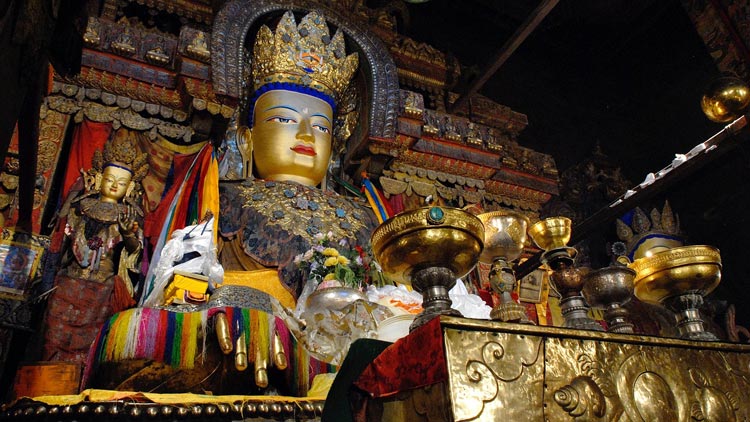
Mandala is a Sanskrit word - the original language at the time of Buddha. Its meaning doesn't directly translate into English. Some say "circle" is the closest equivalent, others refer to it as meaning "world in harmony". Regardless, creation of Mandalas is a ritual of much importance for Tibetan Buddhist monks, and developing the skill to participate in the ritual takes many years.
But this is where we see the first apparent contradiction for outsiders.
If we had the skill to create these pieces, we'd naturally be filled with pride, happy for others to see our work and what we're capable of. But that very pride, the desire for others to appreciate the work, is the opposite of what a true Buddhist life is about. The Christian analogy might be the commandment about coveting, or the Deadly Sin of Avarice.
So in the art of Mandala is perhaps a test, one which is brought to life in our next point.
Insight 2 A Tibetan Mandala is Created to be Destroyed
One of the key tenets of Buddha’s teachings was that life is transient. And this doesn't just apply to people and living things around us. The concept is reflected and reinforced throughout Buddhist life, and in this case is a fundamental idea behind Tibetan Mandala Art.
After spending time creating the Mandala, blessings of deities are called upon to reside within the finished work. But to symbolise the transience of life, the Mandala is immediately swept away (literally with brushes) and poured into an urn.
Bear in mind that the creation of the piece takes days or weeks of intense, non-stop concentration and work, and the slightest mistake would ruin it. So the act of sweeping everything away straight after completion is something we can't imagine doing ourselves . . .
To complete the cycle, the sand from this urn is ceremonially poured into a nearby body of flowing water. This ritual has as much importance as the creation of the Mandala in the first place.
One belief is that the blessings that were part of the Mandala are spread by the water, for others to share.
Insight 3 The Sand Flows Like Liquid
To make the Mandala, a variety of colours of sand are carefully poured over a drawn outline. The first step is to create the outlines, so that sand can be poured into place to create the piece.
A tapering conical funnel tool, called a chak-pur is used to pour the sand, but as with so much else about Mandala, the monks make it look deceptively easy.
The funnel has ridges on it, and monks glide another chak-pur, a metal rod or a piece of wood up and down over the ridges. The aim is to create a steady vibration which disturbs the sand and causes it to flow onto the surface in a constant flow, very much like pouring a liquid. In other words, one mistake causes the wrong piece of coloured sand to sit in the wrong place. And given the intricate patterns, that would destroy the harmony of the whole piece.
The process of building up the full Mandala requires layer upon layer of each colour of sand to be poured alongside and sometimes on top of each other. It takes many days, and is a meticulous task, skilfully carried out by the monks.
The actual pouring is difficult enough to do. But one of the astounding aspects of this art is that there is no guidance for the artists on where to pour which colour, as we see in the next section.

Insight 4 A Tibetan Mandala is Created Solely from Memory
Memorisation has formed a very important principle of Buddhism from the time of Buddha.
Initially, all of the teachings of the Buddha were memorised by monks and nuns, to be passed down in oral form to the next generation. Writing down the texts and teachings only came much later.
And memorisation still plays an important role in Buddhism today. Monks memorise philosophical and religious texts, prayers and rituals. The last of these includes Tibetan Mandala Art symbols.
The Buddhist belief is that when these texts, prayers and rituals are committed to memory, it is deeply instilled in the person, allowing them to reflect on it and epitomise it.
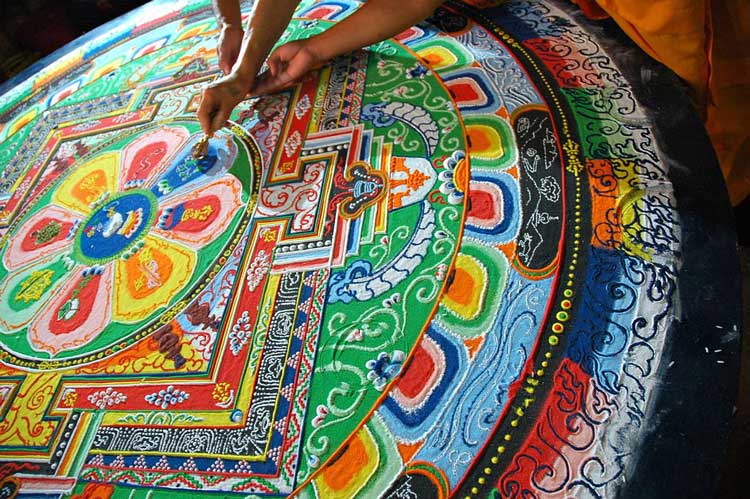
It takes close to two years to just learn all the Tibetan Mandala symbols, then typically another couple to understand and learn to recreate the patterns that form the artwork. So a Monk will have spent 3-4 years of study to start creating their first Mandala.
Insight 5 A Tibetan Mandala Symbolises a Balanced Cosmos
The outer form of these holy circles is a geometrical diagram, known as a Yantra, and each detail of its construction has symbolic meaning.
The monks believe the drawing represents a palace that has the deities within. The deities trace their roots back to the ancient Tibetan spiritual tradition, Bon now absorbed to be part of Tibetan Buddhism.
There is a complex set of relationships amongst the various elements - such as the deities, animals, celestial bodies, the Earth, the weather and fire. The complex relationships are balanced to create a representation of a harmonious universe.
In other words, the beauty of the Mandala is not just aesthetic, but goes much deeper.
Insight 6 Creating a Tibetan Mandala is an Exercise in Enlightenment
Watching the creation of a sand mandala, it is clear is this requires an intense concentration rarely seen in other forms of art. The realisation that hundreds of hours go into creation of one, after thousands of hours of learning, is humbling.
This form of concentration is actually a form of meditation, and an important aspect of the art form that is not easily recognised by anyone other than the practitioners.
This meditation during Mandala creation has a rich tradition, and may even be considered a form of prayer. Our understanding is that this aspect of the art is about the inward calling of Buddhism, the realisation of the spiritual force within the contemplator and artist.
This idea goes further than just contemplation, and there is a connection between the form of meditation experienced and the type of Mandala being created.
There are different mandalas to harmonise with the individual who is meditating and creating the picture. For example, the spiritually mature or experienced, or those who have not begun their spiritual journey yet. The process of this meditation is believed to result in enlightenment.
Insight 7 Tibetan Mandala Art is Believed to Purify and Heal
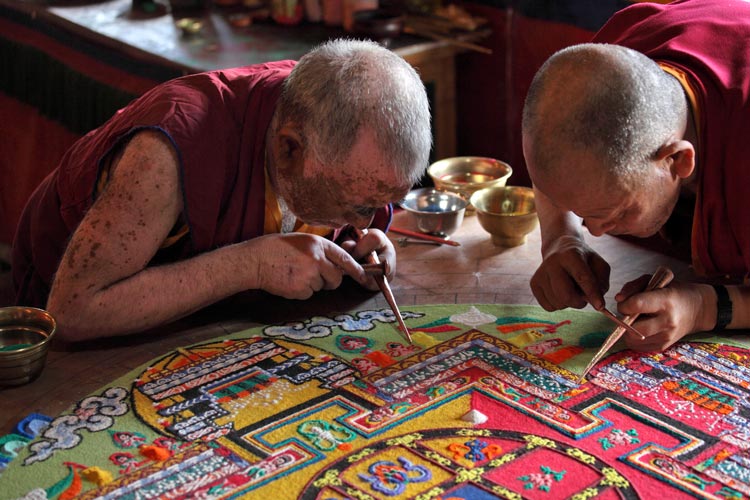
Concentration while creating Tibetan Mandala art
Tibetan Buddhists hold a belief that positive energy goes into a Tibetan Mandala through the meditation of the monks who create it. Even the hum of the chak-pur goes to creating a positive environment in and around the piece as it is being formed.
The monks also chant and meditate after the Mandala is completed, to invoke the spirits of the deities and ask for healing blessings to be imbued into the finished work.
As a result, every Tibetan Mandala is believed to purify and heal not just those who created it, but also those who view it. And as we saw above, the pouring of the sand into flowing water afterwards is about sharing that healing energy with many others beyond the immediate circle.
Conclusions?
Ultimately, a description of Tibetan Mandala Art in words and images is a very limited representation of this deeply spiritual work.
But having seen it in person, and experienced the peace and spirituality of it, we believe any representation is better than not knowing of it at all.
If you're ever fortunate enough to have an opportunity to see Tibetan Buddhist monks practising this tradition, we would urge you to take it.
If you're anything like us, the experience will leave you thoughtful in a way that no other art form has touched us. We can think of no better way to close than with the Dalai Lama's words on the importance of Beauty, and so Art, in the world.
The creatures that inhabit this earth - be they human beings or animals - are here to contribute, each in its own particular way, to the beauty and prosperity of the world.
His Holiness the 14th Dalai Lama


